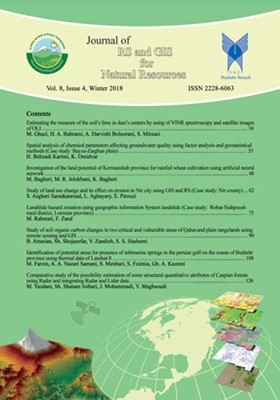-
-
List of Articles
-
Open Access Article
1 - Estimating the measure of the soil’s lime in dust’s centers by using of VINR spectroscopy and satellite images of OLI
Mousa Ghazi Hosseinali Bahrami Ali Darvishi Boloorani Saham Mirzaei -
Open Access Article
2 - Spatial analysis of chemical parameters affecting groundwater quality using factor analysis and geostatistical methods (Case study: Bayza-Zarghan plain)
Hossein Behzadi Karimi Kamal Omidvar -
Open Access Article
3 - Investigation of the land potential of Kermanshah province for rainfed wheat cultivation using artificial neural network
Milad Bagheri Mohammadreza Jelokhani Noaryki Kayvan Bagheri -
Open Access Article
4 - Study of land use change and its effect on erosion in Nir city using GIS and RS (Case study: Nir county)
sayyad asghari saraskanroud Leila Aghayary Elnaz Pirouzi -
Open Access Article
5 - Landslide hazard zonation using geographic information System landslide (Case study: Robat-Siahpoush rural district, Lorestan province)
Maryam Rahmati Farhad Zand -
Open Access Article
6 - Study of soil organic carbon changes in two critical and vulnerable areas of Qahavand plain rangelands using remote sensing and GIS
Behnaz Attaeian Shahrokh Shojaeefar Vahid Zandieh Soheila S. Hashemi -
Open Access Article
7 - Identification of potential areas for presence of submarine springs in the persian gulf on the coasts of Bushehr province using thermal data of Landsat 8
Mohsen Farzin Ali Akbar Nazari Samani Saeideh Menbari Sadat Feiznia Gholam Abbas Kazemi -
Open Access Article
8 - Comparative study of the possibility estimation of some structural quantitative attributes of Caspian forests using Radar and integrating Radar and Lidar data
Mehrsa Yazdani Shaban Shataee Joibari Jahangir Mohammadi Yaser Maghsoudi
-
The rights to this website are owned by the Raimag Press Management System.
Copyright © 2021-2025







